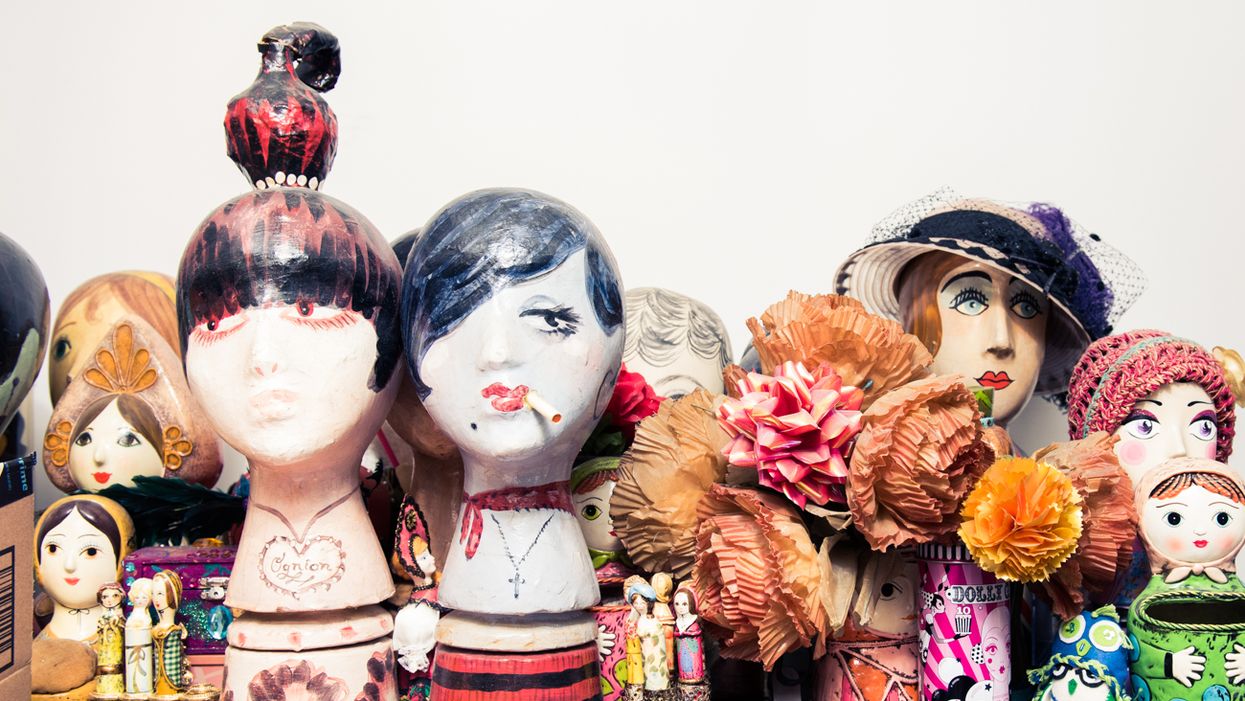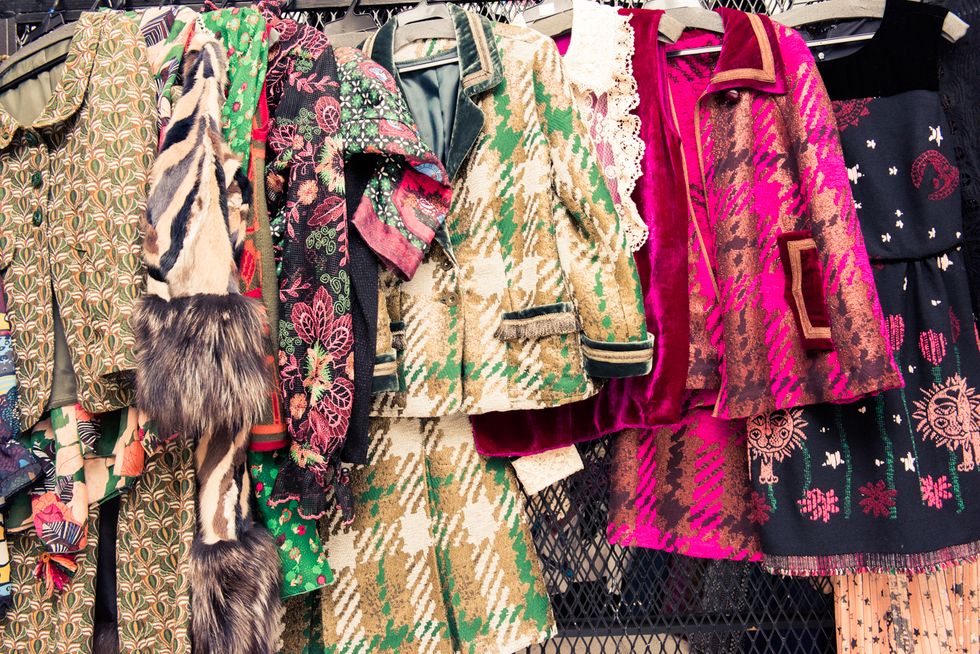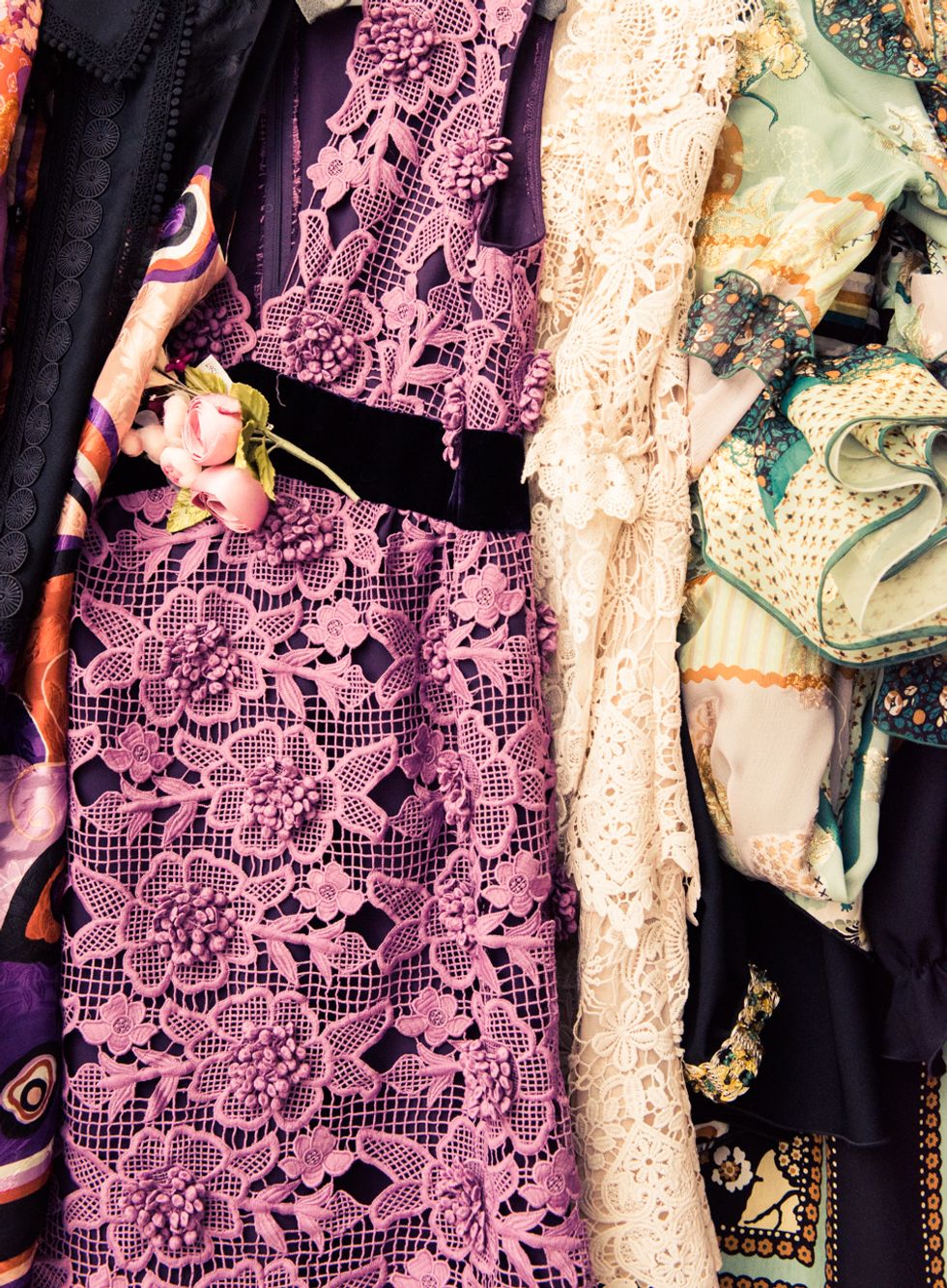What Fashion Week is Like for Anna Sui
The OG designer on last minute changes and her myriad inspirations.

Throughout fashion month, we’re tracking what exactly this circus is like for different people on various sides of the industry. For us, it’s a lot of shows and a lot of Snapchatting, but for a designer, take Anna Sui for example, it’s a completely different situation (as in, a lot longer and a lot more strenuous).
Anna Sui’s show may have happened last night—but, for her, the lead-up is a full six-month-long ordeal, that begins as soon as the last show ends (and we think we’re exhausted after five days of NYFW). But with 25 years of sending clothes down the runway under her patent-leather belt, Sui knows exactly what works for her—even if, to the neophytes listening to her (a.k.a. us) the whole process sounds terrifying. Scratch that: it’s crazy inspiring. Because Sui, from her order-out-of-chaos Garment District studio, sees a collection go from curated moodboards, which act as her guide for the entire process, to fully realized collection—even if the clothes themselves only start coming together three or four weeks out from show time (that’s what we meant by terrifying). And, as always, by the time we actually saw the show last night, it was a flawless collection that appeared to be put together without breaking a sweat. Herein, we find out what it actually takes.

On the preparation time:
“The show really takes a whole six months of preparation—right after the last show, we start working on the next show. It’s a matter of research, looking at all the fabrications that are available, getting a flavor of what’s in the air and really looking at color palettes. That’s when I hope that I get struck by that bolt of lightning where I have this inspiration—either from an exhibition, a movie, a book that I’m reading or just someone I see on the street. It’s usually a combination of all those, so even if you have an initial idea, everything that you experience through the next few months gets thrown in somewhere.”
On her inspiration:
“I start thinking about images that I want to collect and things that I love, and I start putting it up on my inspiration board. The first thing that I do is buy images that personify the inspiration that I’m trying to create. On this season’s board, I was very taken with an exhibition that I saw in London at the Robert Fraser Gallery. He was the guy that was famously busted with Mick Jagger—and I have that famous Richard Hamilton painting up there. He was like the tastemaker of London. He and Christopher Gibbs, whatever they did, whatever they wore, the Stones would follow, The Beatles would follow—they really are the ones who set the pace for everybody else.
There’s this famous David Bailey photograph that’s on the board of an event that was at the gallery. The guy sitting in the middle is a friend of mine—he designed Keith Richards’ skull ring. In the exhibition, they recreated the gallery office. So I have pictures of that up on the wall. They also had the artist that he represented. My favorite was Peter Blake, who’s famous for Sergeant Pepper, but there were so many more things in his studio and a lot of that’s up on the wall. I love a lot of his famous imagery of symbols—the heart, the rainbow, the stars—because those are a lot of the images that I love and use a lot.
I collaborated with Barbara Hulanicki, who started Biba, and she did a really beautiful print for us. It incorporates one of her early drawings with the Peter Blake symbols. We were lucky to have Peter give us his blessing on the print.
The other artist that’s up on the wall is Niki de Saint Phalle—it was another exhibition that I saw in Tokyo. She had a lifelong friendship with a Japanese woman who was one of her main patrons—they had a lot of her Nana art, which was my favorite. Another friend introduced me to her family and we were able to use some of the Nana imagery and we did some embroideries.
It’s a process that evolves, and as I’m living my life, everything just gets pushed into the collection."

On the preparation process:
“We start out with fabrics, with colors, and surprisingly shoes first, because that’s really the longest in terms of development. There are seasons where they arrive just the day before the show, but it’s so much easier when you have the clothes and the shoes together. So you don’t have to call back all the models to try on the shoe and match it with the stockings and so that way we can do the complete outfit.
I would say about four months out we are developing fabrics. We are seeing new collections and seeing new technology; like you’ll see we have these incredible computerized fabrics—they took one of our prints or one of our artworks and made it into a jacquard. It’s something I’d never seen before. With digital printing, you can kind of capture anything, and we’ve been having a lot of fun with that. With all that going on, you’re just trying so many things, developing embroideries, and trying to find new techniques like laser cutting. One of the biggest breakthroughs is computerized lace. It’s just amazing what they can do—you can write your name in lace.
All these developments take time, plus, sometimes they’re not right and we have to tweak them—that takes another four to six weeks. Up until the last minute, you’re still perfecting. We have a few fabrics even now, that we’re really not sure are going to work.

Four weeks before the show is the worst because there are no clothes. The fabrics start coming in and you’re thinking, what am I going to do with it? I sit here and I just look at the fabrics and touch them and see—maybe you’ll make an old style just to see what you can do with the fabric; how you can play with it, how it tailors. And sometimes it doesn’t tailor well at all, and you know you’re not going to bother with it. Four weeks out, very little is done. Maybe there are a few pieces of clothing made up in old styles, just to test the fabric. Then, we’re busy sketching and draping and starting to cut new things.
Three weeks out, maybe we have a handful of styles, and I’ll start trying stuff on, seeing what goes with what. Like if this needs a shirt, this needs pants… We have to fill in—like, oh, I don’t have a pant fabric, I have to find something. And maybe one piece will come out so great that it will inspire a whole different track. You just don’t know. It’s a process. And that’s the thing you always have to keep in mind: that it doesn’t happen overnight. You can’t develop it right away. It takes time and you have to work into it. One thing will lead to another.
At two weeks, we started seriously putting outfits together, seeing what works with what, what’s going to make it and what’s not. We’re editing at that point. You always start out with more than you need. I have one main design assistant and then I have a person that works on fabric, a person that works on embroidery and my assistant, Thomas, who works with me on everything. Right now we’re in the process of putting together a book, too. So, it’s a lot of back and forth about the book and about the collection.
On all the collaborations that go into making the collection:
“I love doing collaborations. So besides the Barbara Hulanicki and Peter Blake and Niki de Saint Phalle, I’m working with John Darrien on something, and James Coviello has been collaborating with me for a show—he’s made some adorable hats. I’m working with Erickson Beamon on beautiful jewelry. For shoes, we’ve been working with Hush Puppies and they make the most adorable shoes out of our fabrics. The tights that we made are with my Japanese license, so we could make them in our prints.
I’m playing with all those elements and putting together outfits not only to my liking, but also featuring all the people that we work with, so that they’re well represented too. It’s always a balance of what’s going to sell, what’s going to get press, what’s going to make me happy.”

On editing the collection:
“I love using Polaroids. It’s almost like a game: every night I lay it out to see how it’s coming out. I also draw out the collection and when I’m drawing, I’m putting together the outfits too. What we have to do is come up with some sort of lineup, put it on the board, then it’s a mathematical thing: I try to hit somewhere between 40 and 50. Sometimes you’re way over, sometimes you don’t have enough—you’re constantly trying to balance the number and also representing everything.
It also doesn’t get edited until you do all your fittings, and then sometimes there’s one outfit that doesn’t work on anybody, so it gets pushed out, no matter how much you love it. It just doesn’t work. Then there’s also a matter of finding the right person to wear everything. And really up until the night before the show when I have to do the program, that’s when I have to make the final decision, because they need to print it out. Now we have a little bit more time because everything’s much faster, but in the old days, with the old computers, it would just take forever and we’d be here all night doing that program.”
On casting:
“I’ve been casting all along. I’m trying to see all the new models. It makes it exciting, especially if we discover somebody that’s just going to spark it. Then I have the girls I love using that I use over and over again. It’s another balance: what’s going to look fresh, but what’s going to be reliable.”
On her closest collaborators:
“I have a meeting with Pat McGrath and Garren about a week before the show. They come and look at the clothes, we’ll have a model here, she’ll try on the clothes and then we play and try to come up with something. And throughout this whole process, I’m constantly asking Steven Meisel. He sees everything. I call him ‘headquarters.’ It’s like I have to check in. Who better to bounce ideas off of? I’m just so fortunate and he’s so generous, so that’s how the casting really happens, too—it’s Steven.”
On the day of the show:
“That’s probably the calmest day. I have to drink extra coffee because suddenly, you don’t have that pressure and all of a sudden you’re so tired and you just want to go to sleep. I remember before one show I went home and took a nap—all of a sudden that pressure’s gone, you don’t know what to do with your time. It’s funny because my parents always came to stay with me every show, and one year, the morning of the show when I was getting ready, I was getting dressed and I saw my mom watching me. I was like, 'Is this alright?' and she said, 'Yeah, it’s okay!' and I was like, 'Okay! I’ll see you at the show!' And she’s like, 'Well, what are you going to wear to the show?' It’s just like, this is it, mom! And she’s like, 'Why can’t you dress like a designer?' [laughs] It’s funny because no matter what, there’s always that. Your parents just know you the best, and kind of always have the last word. No matter what your fantasy is, your mom can just like put you down right on the ground.”

On being backstage:
“We get there probably an hour and a half to two hours before. Depending on what’s going on before that, sometimes it’s occupied, the space. We have that three-hour turnaround, and usually that first hour they’re just waiting for people to show up and we’re waiting for clothes to get finished. So we try to bring as much as we can when we go, even though when there’s one initial delivery, there’s always the leftover things. Sometimes we even have to take pieces to the venue to try it on for the first time to make sure it’s alrgith. If not, we have to send it back and get it fixed. It’s all up until the last minute. There was one time we realized that we were using the same pair of pants for two outfits and we didn’t have that pant. So luckily, it was at Bryant Park and we were able to make it like an hour before the show. You never know.”